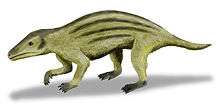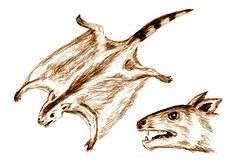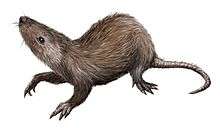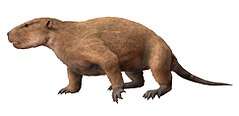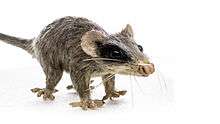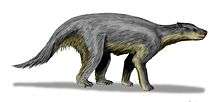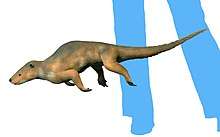Deltatheroida
Deltatheroida is an extinct group of basal metatherians that were distantly related to modern marsupials.[2] The majority of known members of the group lived in the Cretaceous; one species, Gurbanodelta kara, is known from the late Paleocene (Gashatan) of China.[3] Their fossils are restricted to Central Asia and North America. This order can be defined as all metatherians closer to Deltatheridium than to Marsupialia.
| Deltatheroida | |
|---|---|
| Scientific classification | |
| Kingdom: | Animalia |
| Phylum: | Chordata |
| Class: | Mammalia |
| Clade: | Metatheria |
| Order: | †Deltatheroida Gregory and Simpson, 1926 |
| Families & Genera | |
| |
These mammals possessed tritubercular (three-cusped) lower molars and these were not tribosphenic and were quite primitive. This is awkward because tribosphenic molars are commonly found in most therian mammals (there exist some exceptions such as anteaters and some whales, which have no teeth at all).
When they were first identified in the 1920s, they were believed to be placentals and possible ancestors of the "creodonts" (a polyphyletic group of extinct carnivorous mammals from the Paleogene and Miocene), but this was later disproven. Nonetheless, deltatheroideans do converge on hyaenodontids, oxyaenids, carnivorans, dasyuromorphs and sparassodonts in many details of their dental anatomy, suggesting a carnivorous lifestyle.[4]
Taxonomy
The following is a species list of Deltatheroida.[5][6]
†Deltatheroida Kielan-Jaworowska 1982 [Deltatheralia Marshall & Kielan-Jaworowska 1992; Holarctidelphia Szalay 1993]
- †Pappotheriidae
- †Deltatheridiidae Gregory & Simpson 1926 [Deltatheridia Van Valen 1965; Nanocuridae Fox, Scott & Bryant 2007; Sulestinae Nessov 1985; Deltatheroididae Kielan-Jaworowska & Nesov 1990]
- †Hyotheridium dobsoni Gregory & Simpson 1926
- †Lotheridium mengi Bi et al. 2015
- †Nanocuris improvida Fox, Scott & Bryant 2007
- †Prodeltitheridium kalandadze Trofimov 1984
- †Oklatheridium Davis, Cifelli & Kielan-Jaworowska 2008
- †O. szalayi Davis, Cifelli & Kielan-Jaworowska 2008
- †O. minax Davis & Cifelli 2011
- †O. wiblei Cifelli & Davis 2015
- †Atokatheridium boreni Kielan-Jaworowska & Cifelli 2001
- †Deltatheridium Gregory & Simpson 1926
- †D. pretrituberculare Gregory & Simpson 1926
- †D. nesovi Averianov 1997
- †Sulestes karakshi Nesov 1985 [Deltatherus Nesov 1997; Marsasia Nesov 1997; Deltatheroides kizylkumensis Nesov 1993; Deltatherus kizylkumensis (Nesov 1993) Nesov 1997; Marsasia aenigma Nesov 1997]
- †Tsagandelta dashzevegi Rougier, Davis & Novacek 2015
- †Deltatheroides cretacicus Gregory & Simpson 1926
- †Gurbanodelta kara Ni et al. 2016
Biology
Deltatheroideans are thought to be carnivorous mammals, converging on hyaenodontids, oxyaenids, carnivorans, dasyuromorphs and sparassodonts in many details of their dental anatomy, suggesting a carnivorous lifestyle.[4][8]
Deltatheroideans in this regard appear to have replaced eutriconodont mammals as the dominant carnivorous mammals of the Mesozoic, either directly through competition or occupying vacant ecological niches; in North America, Nanocuris came to succeed the larger gobiconodontids and Jugulator, while in Asia the Early Cretaceous gobiconodontid radiation is replaced in the Late Cretaceous by a deltatheroidean one.[9] Given that all insectivorous and carnivorous mammals groups suffered heavy losses during the mid-Cretaceous, it seems likely these metatherians simply occupied niches left after the extinction of eutriconodonts.[10]
Evidence of direct predation on dinosaurs may be attested on a skull belonging to Archaeornithoides, which seems to have been punctured by Deltatheridium teeth and later healed.[11]
See also
References
- Guillermo W. Rougier; Brian M. Davis; Michael J. Novacek (2015). "A deltatheroidan mammal from the Upper Cretaceous Baynshiree Formation, eastern Mongolia". Cretaceous Research. 52, Part A: 167–177. doi:10.1016/j.cretres.2014.09.009.
- Wilson, G.P.; Ekdale, E.G.; Hoganson, J.W.; Calede, J.J.; Linden, A.V. (2016). "A large carnivorous mammal from the Late Cretaceous and the North American origin of marsupials". Nature Communications. 7: 13734. doi:10.1038/ncomms13734. PMC 5155139. PMID 27929063.
- Xijun Ni; Qiang Li; Thomas A. Stidham; Lüzhou Li; Xiaoyu Lu; Jin Meng (2016). "A late Paleocene probable metatherian (?deltatheroidan) survivor of the Cretaceous mass extinction". Scientific Reports. 6: Article number 38547. doi:10.1038/srep38547. PMC 5141426. PMID 27924847.
- CHRISTIAN DE MUIZON and BRIGITTE LANGE-BADRÉ, Carnivorous dental adaptations in tribosphenic mammals and phylogenetic reconstruction, Article first published online: 29 MAR 2007 DOI: 10.1111/j.1502-3931.1997.tb00481
- Mikko's Phylogeny Archive Haaramo, Mikko (2007). "†Deltatheroida – deltatherids". Retrieved 30 December 2015.
- Paleofile.com (net, info) "Archived copy". Archived from the original on 2016-01-11. Retrieved 2015-12-30.CS1 maint: archived copy as title (link). "Taxonomic lists- Mammals". Archived from the original on 11 January 2016. Retrieved 30 December 2015.
- S. Bi, X. Jin, S. Li and T. Du. 2015. A new Cretaceous metatherian mammal from Henan, China. PeerJ 3:e896
- Zofia Kielan-Jaworowska; Richard L. Cifelli; Zhe-Xi Luo (2004). "Chapter 12: Metatherians". Mammals from the Age of Dinosaurs: origins, evolution, and structure. New York: Columbia University Press. pp. 425–262. ISBN 0-231-11918-6.
- G. W. Rougier, B. M. Davis, and M. J. Novacek. 2015. A deltatheroidan mammal from the Upper Cretaceous Baynshiree Formation, eastern Mongolia. Cretaceous Research 52:167-177
- David M. Grossnickle, P. David Polly, Mammal disparity decreases during the Cretaceous angiosperm radiation, Published 2 October 2013.DOI: 10.1098/rspb.2013.2110
- Elżanowski, A. Wellnhoffer, P. (1993). "Skull of Archaeornithoides From the Upper Cretaceous of Mongolia". earth.geology.yale.edu/~ajs/1993/11.1993.08Elzanowski.pdf . American Journal of Science
Further reading
Zofia Kielan-Jaworowska, Richard L. Cifelli, and Zhe-Xi Luo, Mammals from the Age of Dinosaurs: Origins, Evolution, and Structure (New York: Columbia University Press, 2004), 444-448.

